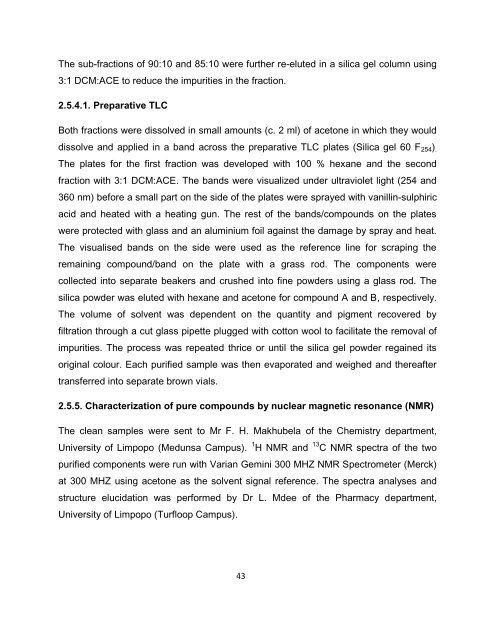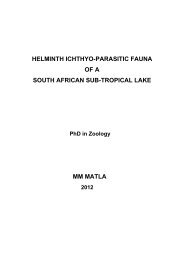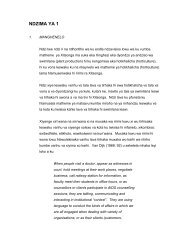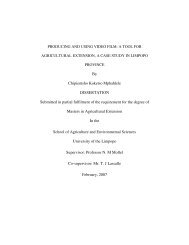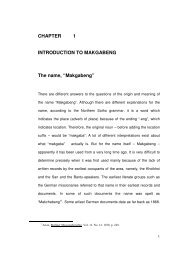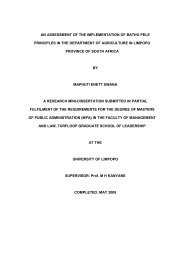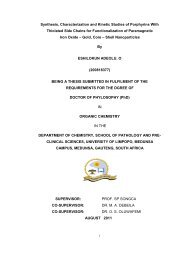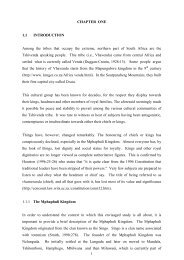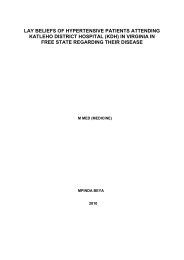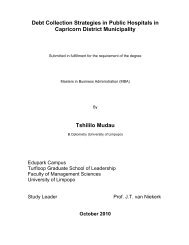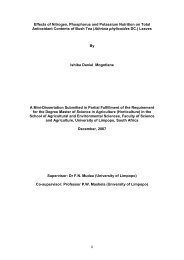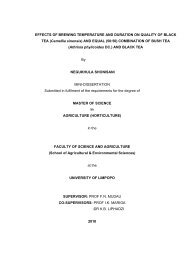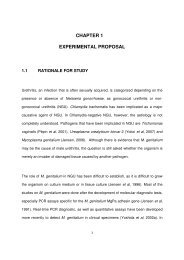Mmushi T MSc (Microbiology).pdf
Mmushi T MSc (Microbiology).pdf
Mmushi T MSc (Microbiology).pdf
You also want an ePaper? Increase the reach of your titles
YUMPU automatically turns print PDFs into web optimized ePapers that Google loves.
The sub-fractions of 90:10 and 85:10 were further re-eluted in a silica gel column using<br />
3:1 DCM:ACE to reduce the impurities in the fraction.<br />
2.5.4.1. Preparative TLC<br />
Both fractions were dissolved in small amounts (c. 2 ml) of acetone in which they would<br />
dissolve and applied in a band across the preparative TLC plates (Silica gel 60 F 254 ) .<br />
The plates for the first fraction was developed with 100 % hexane and the second<br />
fraction with 3:1 DCM:ACE. The bands were visualized under ultraviolet light (254 and<br />
360 nm) before a small part on the side of the plates were sprayed with vanillin-sulphiric<br />
acid and heated with a heating gun. The rest of the bands/compounds on the plates<br />
were protected with glass and an aluminium foil against the damage by spray and heat.<br />
The visualised bands on the side were used as the reference line for scraping the<br />
remaining compound/band on the plate with a grass rod. The components were<br />
collected into separate beakers and crushed into fine powders using a glass rod. The<br />
silica powder was eluted with hexane and acetone for compound A and B, respectively.<br />
The volume of solvent was dependent on the quantity and pigment recovered by<br />
filtration through a cut glass pipette plugged with cotton wool to facilitate the removal of<br />
impurities. The process was repeated thrice or until the silica gel powder regained its<br />
original colour. Each purified sample was then evaporated and weighed and thereafter<br />
transferred into separate brown vials.<br />
2.5.5. Characterization of pure compounds by nuclear magnetic resonance (NMR)<br />
The clean samples were sent to Mr F. H. Makhubela of the Chemistry department,<br />
University of Limpopo (Medunsa Campus). 1 H NMR and 13 C NMR spectra of the two<br />
purified components were run with Varian Gemini 300 MHZ NMR Spectrometer (Merck)<br />
at 300 MHZ using acetone as the solvent signal reference. The spectra analyses and<br />
structure elucidation was performed by Dr L. Mdee of the Pharmacy department,<br />
University of Limpopo (Turfloop Campus).<br />
43


